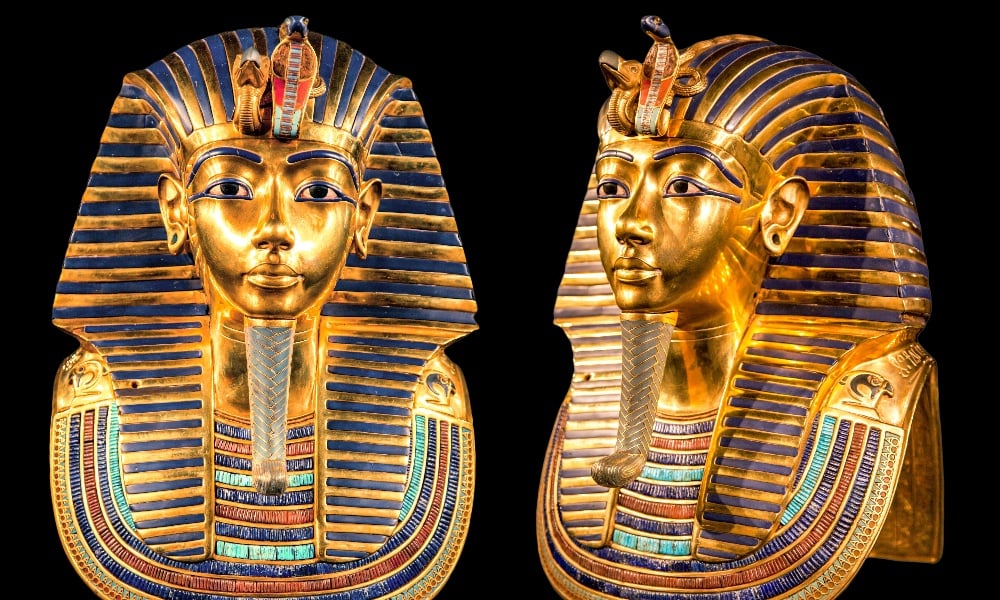Estimated reading time: 7 minutes
The Enigmatic Mummification of King Tutankhamun
King Tutankhamun, known as the “Boy King,” has intrigued people for years. His tomb, found in 1922 by archaeologist Howard Carter, was full of ancient Egyptian treasures and mysteries. One mystery is that Tutankhamun was mummified with an erect penis. This strange detail has led to many theories about its meaning.
A Historical Overview of Tutankhamun’s Reign
The Boy King and His Legacy
Tutankhamun became king when he was about nine or ten years old, during a time of change in Egypt. His father, Akhenaten, had changed the religion to focus on one god, Aten, instead of many gods. This caused problems for the people and priests.
During his short reign, Tutankhamun worked to bring back the old religious ways. He restored the worship of the traditional gods and moved the capital back to Thebes. Even though he was young, his actions helped stabilize the country and return to the old cultural norms.
The Discovery of Tutankhamun’s Tomb
Finding Tutankhamun’s tomb in the Valley of the Kings was a big deal in archaeology. Unlike other tombs that had been robbed, his was mostly untouched, showing the wealth and splendor of ancient Egyptian burial practices.
Howard Carter’s careful work uncovered many treasures, like the famous golden death mask, decorated chariots, and lots of jewelry. These items showed the skill of ancient Egyptian artists and the importance of preparing for the afterlife.
The tomb’s discovery fascinated the world and renewed interest in ancient Egypt. It also highlighted the strange detail of Tutankhamun’s mummification, which has become a topic of study and curiosity.
Unveiling the Mysteries of Mummification
Ancient Egyptian Burial Practices
Mummification was a sacred process in ancient Egypt, meant to preserve the body for the afterlife. Egyptians believed the body was needed for the soul’s journey in the next world. They took great care to prepare and protect it.
The process involved removing internal organs, which were kept in special jars. The body was dried with natron, a type of salt, and wrapped in linen bandages. Amulets were placed between the layers for protection.
Finally, the mummified body was placed in decorated coffins with inscriptions to guide and protect the deceased in the afterlife. This careful process showed the Egyptians’ strong beliefs in the afterlife and the need to keep the body intact.
The Unique Case of Tutankhamun’s Mummification
The Tutankhamun Erect Penis Phenomenon
One of the most puzzling aspects of Tutankhamun’s burial is that he was mummified with an erect penis. That’s right King Tutankhamun erect penis was preserved during his mummification. This has led to different theories about its meaning in ancient Egyptian beliefs.

One theory is that it symbolized a connection to the god Osiris, who had a link to fertility and the afterlife. The erect penis could represent rebirth and renewal, fitting with the themes of resurrection and eternal life in Egyptian religion.
Another theory is that it was a response to the religious changes made by Tutankhamun’s father, Akhenaten. By showing Tutankhamun in a traditional way, it reinforced the old religious order and the gods, including Osiris. This shows the mix of religion, politics, and symbolism in ancient Egypt.
Theories Behind the Erect Mummification
Salima Ikram’s Osiris Connection Theory
Symbolism of Fertility and Regeneration
Egyptologist Salima Ikram suggests that Tutankhamun’s erect mummification connected him to Osiris. Osiris was a key figure in Egyptian mythology, linked to life, death, and rebirth. He was often shown with an erect phallus, symbolizing fertility and regeneration.
Ikram believes that Tutankhamun’s mummification was meant to show Osiris at his most powerful, aligning with the idea of rebirth in the afterlife. This highlights the importance of fertility and renewal in Egyptian beliefs and the desire for a successful transition to the next world.
The erect penis symbolizes not just physical regeneration but also the continuation of the pharaoh’s legacy and the divine order. By embodying Osiris’s traits, Tutankhamun was seen as a strong and lasting figure.
Counteracting Akhenaten’s Religious Revolution
Restoring the Old Religious Order
Another theory is that the erect mummification was a statement against Akhenaten’s religious changes. Akhenaten’s focus on one god, Aten, disrupted Egypt’s traditional religion, causing unrest.
Tutankhamun’s reign marked a return to polytheism and the old religious ways. By showing Tutankhamun in a traditional form, it reinforced the gods and cultural norms disrupted by his father’s changes. The erect mummification was a symbol of this restoration, emphasizing the pharaoh’s role as a link between gods and people.
This theory shows the complex mix of religion, politics, and symbolism in ancient Egypt and the importance of keeping the divine order balanced. It also highlights Tutankhamun’s role in stabilizing the nation and restoring cultural norms.
The Interplay of Religion, Politics, and Symbolism
The Role of Osiris in Ancient Egyptian Beliefs
Osiris was a central figure in Egyptian mythology, representing life, death, and rebirth. As the god of the afterlife and fertility, Osiris was important in Egyptian beliefs and practices.
The story of Osiris involves his murder by his brother Set and his resurrection by his wife, Isis. This tale of death and rebirth resonated with Egyptians, who saw Osiris as a symbol of hope and renewal. His link to fertility and regeneration made him important in Tutankhamun’s mummification, fitting with themes of resurrection and eternal life.
Depictions of Osiris was often include an erect phallus, emphasizing his role as a symbol of fertility and regeneration. This imagery represented physical renewal and the continuation of the pharaoh’s legacy. By embodying Osiris’s traits, people perceived Tutankhamun as a strong and lasting figure.
The Impact of Akhenaten’s Monotheism
Akhenaten’s shift to monotheism and worship of Aten was a big change from Egypt’s polytheistic tradition. This religious revolution disrupted Egypt’s traditional religion, causing unrest.
Akhenaten’s changes challenged the established order and cultural norms. The focus on Aten marginalized traditional gods and priests, leading to instability.
Tutankhamun’s reign marked a return to polytheism and the old religious order. By restoring the worship of traditional gods and moving the capital back to Thebes, Tutankhamun signaled a return to the familiar. This restoration was a political move and a symbol of continuity and stability.
The mix of religion, politics, and symbolism in ancient Egypt shows the complexity of its history. It highlights the power of cultural narratives and the importance of understanding historical contexts in shaping beliefs and practices.
Modern Interpretations and Cultural Reflections
The Fascination with Tutankhamun in Popular Culture
Tutankhamun’s story continues to captivate people, inspiring documentaries, exhibitions, and cultural references. His tomb and its mysteries symbolize the allure of ancient Egypt, drawing visitors to museums worldwide.
The fascination with Tutankhamun reflects the historical and archaeological significance of his tomb and the appeal of ancient Egyptian culture. The wealth and mystery of Tutankhamun’s burial have captured imaginations, fueling ongoing interest.
In popular culture, Tutankhamun represents the alluring and mysterious, symbolizing a civilization that continues to intrigue and inspire. His story reminds us of the richness and complexity of ancient Egypt and the power of its cultural narratives.
Lessons from Ancient Egypt for Today’s Society
The mix of religion, politics, and symbolism in ancient Egypt offers insights for today’s society. It highlights the importance of understanding historical contexts and the power of cultural narratives in shaping beliefs and practices.
In today’s world, where identity, representation, and inclusivity are important, Tutankhamun’s story reminds us of the need to preserve and respect cultural heritage. It underscores the value of diversity and the need to embrace different cultures and traditions.
Lessons from ancient Egypt are relevant to historians and anyone interested in understanding human civilization’s complexities. They offer a window into the past, providing insights into the beliefs, practices, and values that have shaped societies.
More Stories

